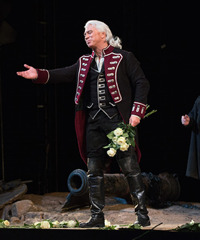| Opera Reviews | 26 April 2024 |
A Trovatore for the history booksby Steve Cohen |
|
| Verdi: Il Trovatore
Metropolitan Opera (HD simulcast) October 2015 |
|
|
First, because Azucena was Verdi’s original choice for the opera’s title, let’s salute the woman who played that role as she celebrated 25 years since her debut in the same role. Delora Zajick inhabited the wild gypsy mother, projecting her gutsy chest tones as strongly as ever. At age 63 she’s performed the part more often than any other person in the Met’s history, and this was a testament to her mastery of it. Second is the circumstance that baritone Dmitri Hvorostovsky was giving his last performance before flying to London for brain surgery. The 52-year-old Siberian has received treatments for a brain tumor since June, cancelled most of his performances since then, and now will undergo surgery at the Royal Marsden Hospital, which specializes in cancer. Miraculously, the tumor did not affect his singing or acting. (I’m told he has problems with balance, but none of that was apparent.) For the past twenty years Hvorostovsky has given immense pleasure with his suave singing and handsome stage presence. You may have other favorites among the great baritones, but no one can dispute that Hvorostovsky has the most gorgeous tone of all. His velvety sound has no equal in history, except perhaps for Ettore Bastianini. That Italian star had a somewhat similar tone and, ironically, died in mid-career of throat cancer at the age of 44 in 1967. On this occasion Hvorostovsky sang with smooth legato, with plush soft passages and a ringing high G at the end of his Il balen del suo sorriso (“the flash of her smile”) aria. That top note rang even more brilliantly on the telecast than it did on opening night. And his sound was richer than when I saw him in this production’s 2009 debut. His cast, and the audience, and the Met orchestra all gave him long, well-deserved ovations. He can bask in the warmth of their love as he leaves for an uncertain future. Also deserving raves was the Leonora, Anna Netrebko. Until now, most of her fame was centered on being photogenic. Previously she sang lyric parts and fluttery high coloratura roles, not without blemish. I’ve been outspoken in my criticism of her smudging of rapid notes and her occasional flatness on the top ones. Now she has moved successfully into the demanding province of dramatic Verdi heroines. To my amazement and pleasure she did so with a fuller sound than before, powerful low notes and the essential mastery of the long Verdian line. This was most noticeable in Act IV when she had the romantic aria D’amor sull’ali rosee (“Fly on rosy wings”) with its rippling rhythm, followed immediately by her duet with the off-stage tenor, the Miserere in which she has to sound like a deep mezzo, and then the rapid cabaletta Tu vedrai che amore in terra (“There was on earth no love stronger than mine”) — all of this without a rest. Netrebko deserves congratulation for not settling on her fame, but developing as an artist. Now I can’t wait for her to assume the other major Verdi soprano roles in Un Ballo in Maschera , La Forza del Destino, Don Carlo, etc. Alone among the principals, the tenor’s voice was earthbound. Yonghoon Lee sang with musicianship and varied his volume from piano to stirring loud passages, but seemed to be pushing uncomfortably. His tones emanated from a tight throat rather than being placed in the “mask” so they would reverberate from the top of his head to the topmost balcony. And he sometimes was a tad flat. The performance was telecast live in HD and will be re-broadcast. Gary Halvorson efficiently directed the drama. The production by David McVicar with sets by Charles Edwards conjured Goya’s Spain with scorched landscapes and dark castles, cloisters and courtyards. A visual and aural highlight was the Anvil Chorus, where muscular men executed rhythmically coordinated swings with heavy steel hammers. The opening curtain was of Goya’s “The Disasters of War” and it suggested imminent danger. Very appropriate. The set rotated between scenes, which looked ponderous in the house but worked nicely with dissolving images on the cinema screen.
|
|
| Text ©
Steve Cohen Photos © Cory Weaver / Metropolitan Opera |

 The Met’s latest HD screening was one of those grand experiences that devotees will remember, like Shakespeare’s “gentlemen in England now-a-bed”, those who missed it “shall think themselves accurs'd they were not here.” The performance of October 3 was even better than at the opening night eight days previously.
The Met’s latest HD screening was one of those grand experiences that devotees will remember, like Shakespeare’s “gentlemen in England now-a-bed”, those who missed it “shall think themselves accurs'd they were not here.” The performance of October 3 was even better than at the opening night eight days previously.





